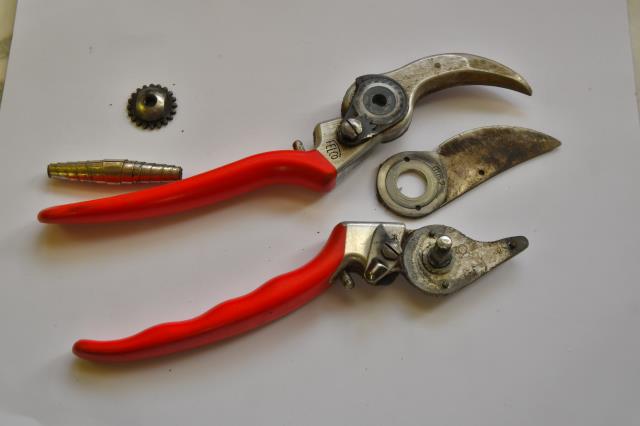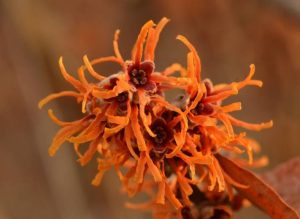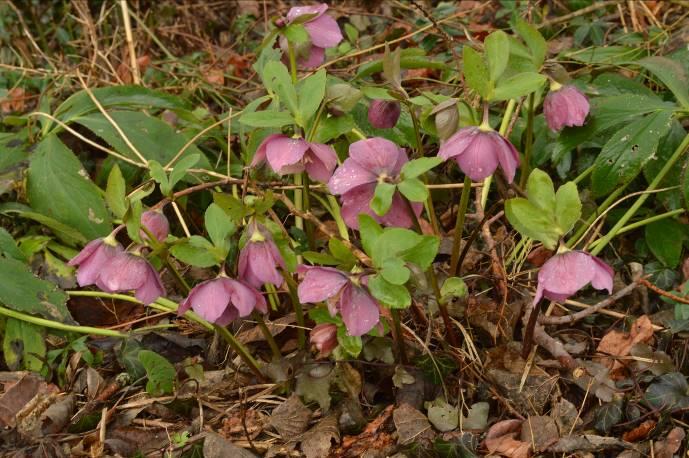The month of January provided near average temperatures for the month, although the start of February is forecast to be colder as I write these notes. February is the month to finalize any design considerations for the year to come since March becomes busy with gardening activities. This month is also the time to complete the ordering of seeds, since many of the more popular varieties will soon become sold out. On warmer days, make it a point to walk through your garden, enjoying its beauty and giving thought to exciting new spring improvements. Reread your journals from last year, and focus upon how to improve those parts of the garden that performed poorly or on how to repeat last years’ success stories!
Things to do:
- Sharpen pruners and handsaws in preparation of the many pruning tasks to come. If you own a by-pass pruner, like a Felco (pictured at right) or Corona, take the pruner apart to sharpen since the side of the blade without the beveled edge needs to be laid flat on a sharpening stone to sharpen.
- If you own a saw with a tri-edge blade that is dull, they are notoriously difficult to sharpen and it is probably best to simple purchase a new blade.
- Clean and sharpen the edge of spades, as well as make certain wheelbarrows and other tools are in good shape for the season to come.
- Start to prune fruit trees, including apple, pear and quince as well as grapevines. For budded fruit trees, including Pawpaws (Asimina), make certain to remove root suckers, since they are actually the understock and are not the plant/fruit variety that you wanted.
- Prune winter damaged branches if your garden experienced snow, ice or wind damage. When pruning back to a trunk, be certain not to remove the swelling where the branch meets the trunk, otherwise called the branch collar. The collar aids in the healing process.
- Should it snow this month, knock the snow off of shrubs to reduce limb breakage.
- Begin to prune multi-stemmed shrubs, such as Forsythia, Lilac, Deutzia and Weigela. These plants flower best on younger stems necessitating the removal of 1 to several of the oldest canes in order to provide light for the growth of new canes. For Lilac, if the plant only has one or two large trunks and it is not suckering, it is most likely grafted onto privet understock. In these cases, it is safer not to prune the plant back harshly, since it will not sucker from the base.
- Bring Forsythia, Quince and Witch Hazel (Vernal Witch Hazel is pictured below right) branches into the house for forcing or to enjoy the flowers and fragrance should they be in bloom.
- Clean-up the greenhouse. Check on the heat mats and grow lights to make certain everything works and is clean. Check as well for sufficient potting soil, labels, fresh markers for labelling and pots for the seeding and potting tasks to come?
- Near the end of the month, start to sow seeds indoors for cool season crops such as Broccoli, Cabbage and Leeks and for warmer season crops or ornamentals, such as Begonias, Eggplants and Hot Peppers.
- Finish ordering seed for spring. Go through your stored seed and discard packages that are over 2 years old. Or, you can place some of the older seeds on a moist paper towel and place in a warm spot (like on top of the refrigerator) to evaluate the percentage of germination. If few seeds germinate, discard the package. Organize them by sowing time to make life easier for April and May!
- Check on the bulbs that you have brought into the garage or placed in a protected spot outside for forcing. The Crocus and Snowdrops should be ready to bring inside soon for you to enjoy.
- Check on stored tubers and corms, such as Canna or Elephant Ears. Discard any that are showing signs of decay.
- With the days becoming longer towards the end of the month, begin to water indoor plants more frequently – but do not saturate, since that will encourage fungus gnats & root decay.
- Cut back Lenten Rose (Hellebore x hybridus) foliage (pictured at right) and other early bloomers, such that the foliage does not distract from the floral display. Watch areas where early spring bulbs are planted for some early color (and to avoid stepping on them!)
- Cut back any matt forming perennials, such as Nepeta (Catmint). Often rodents will hide beneath the foliage and either eat the crowns or create homes. Leave behind any fallen leaves or lightly mulch to protect the crowns from freezing temperatures.
- Do not remove any temporary winter mulch on Perennial beds, such as the boughs from the Christmas tree, unless it is around those early spring blooming bulbs. Late February and early March can still be bitterly cold.
- Continue to apply anti-desiccant sprays to recently planted Rhododendrons, Hollies, Camellias or other evergreens that are in an exposed location on days with above freezing temperatures.
- Watch for deer predation and set up fencing if needed.
- When temperatures rise into the 40’s, get a head start on edging those bedlines and spreading mulch where possible. Every day that you can complete a springtime chore will relieve some of the burden of the April panic to get everything done.



Bruce Crawford
State Program Leader, Home and Public Horticulture (NJAES)



